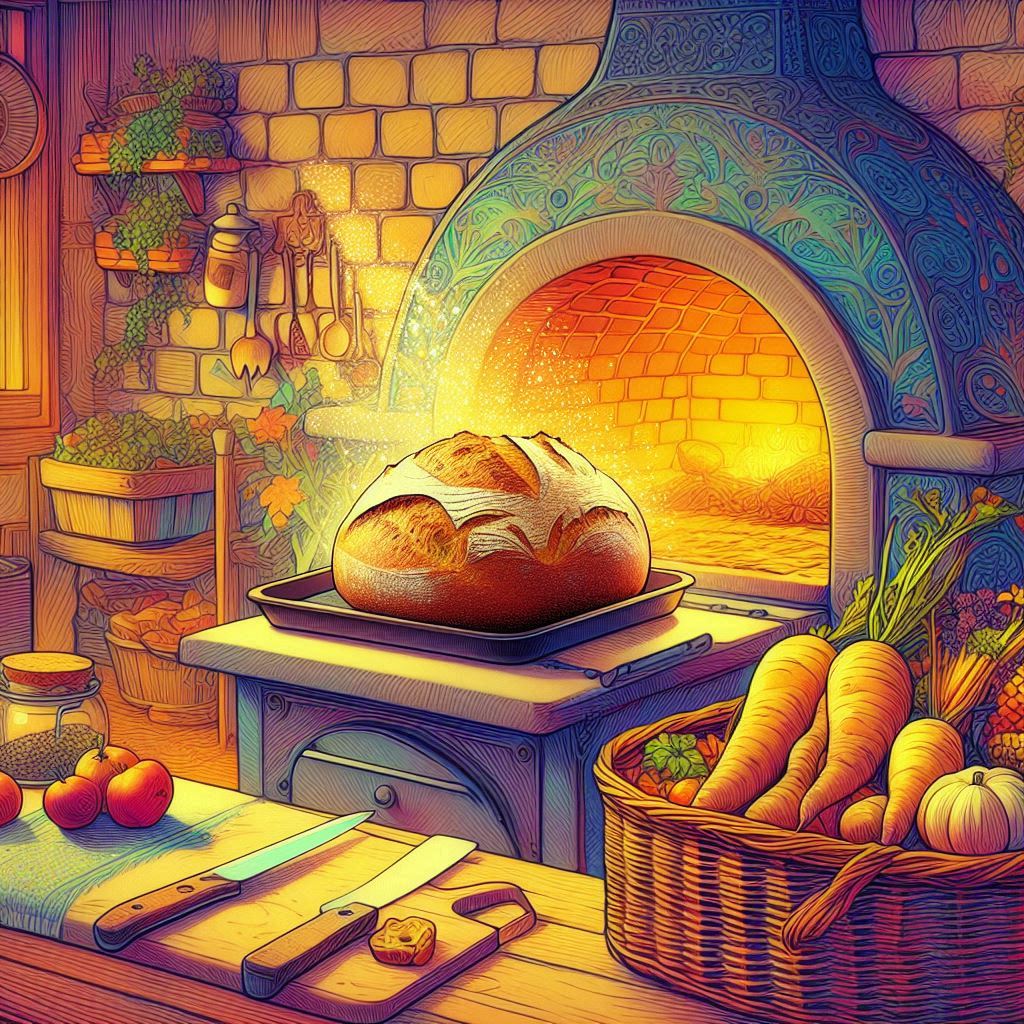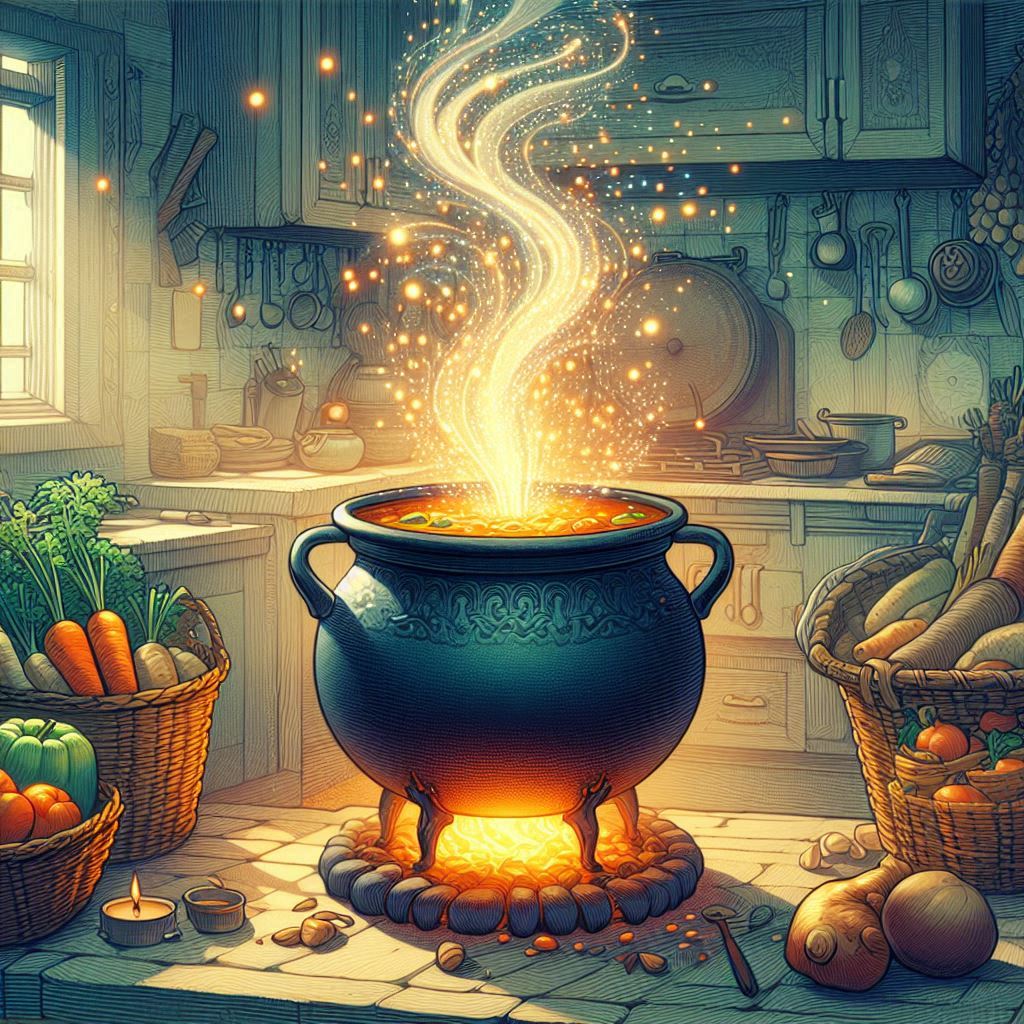Why Warmth Matters in More Ways Than One
As the days shorten and the air turns crisp, we instinctively reach for bowls of stew, roasted roots, and loaves of bread pulled from the oven.
On the surface, these foods are practical.
They’re warming your body, stoking digestion, and providing the dense calories that colder weather demands.
But on a deeper level, warm foods nourish more than just your physical body.
They also carry an energetic signature.
They’re grounding, comforting, and fortifying.
They remind us of the hearth fire, of ancient rituals of survival, and of the alchemy that transforms raw ingredients into soul food.
Food magic has always been about more than sustenance.
It’s about relationship.
Between land and eater, farmer and kitchen, the outer cycles of the seasons and the inner cycles of the soul.
In winter, when the world contracts and the veil of cold presses close, the foods we choose act as medicine, talisman, and teacher.
In this article you’ll learn more about the energetics of warm foods, unearthing why slow stews, roasted tubers, and baked grains have been honored across time as portals of nourishment and magic.
I’ve also included some super simple recipes for inspiration for some hearth alchemy in your own kitchen.
The Biology of Warm Foods: Digestive Fire and Seasonal Wisdom

So, biologically speaking, the human body thrives when it’s in harmony with the environment.
In cold weather, your body expends more energy maintaining its internal temperature.
Warming foods do double duty.
They literally keep you warm and they also support your body’s metabolic processes.
- Slow cooking breaks down fibers, making food easier to digest.
- Roasting and baking caramelize natural sugars, providing quick energy while enhancing flavor.
- Warm liquids—soups, teas, broths—hydrate and soothe while stimulating circulation.
Traditional systems of medicine understood this long before science confirmed it.
Understanding The Inner Fire of Digestion in Traditional Chinese Medicine

In Traditional Chinese Medicine (TCM), winter is associated with the element of Water, governed by the Kidneys and Bladder.
Winter energy is inward, conserving essence (jing), building reserves, and protecting the body’s vital core.
But even in the season of Water, the strength of your body depends on the integrity of its digestive fire (the Spleen and Stomach Qi) sometimes referred to as the “middle burner.”
- Spleen Qi transforms food into usable energy (Qi) and Blood.
- Stomach Qi receives and ripens food, orchestrating digestion.
- When these systems are weak, dampness and cold can accumulate, leading to fatigue, poor immunity, bloating, or sluggish digestion.
That’s why warm, cooked foods are emphasized in winter.
They support the Spleen’s preference for warmth and dryness.
Eating too many raw or cold foods during the cold season can extinguish your digestive fire, and create imbalance…which can ultimately lead to disharmony in the body or even disease.
TCM Food Energetics in Winter
In TCM, foods are understood not just nutritionally but also by their energetic qualities. For example:
- Warming foods (yang in nature) include ginger, garlic, onions, leeks, cinnamon, lamb, chicken, and oats. These fortify Kidney yang and help circulate warmth through the body.
- Neutral and sweet foods—like rice, carrots, winter squash, and barley—strengthen Spleen Qi and provide steady energy without overstimulating.
- Salty foods like seaweed, miso, or black beans nourish the Water element, supporting Kidney health and deep reserves.
- Dark-colored and black foods (black sesame, kidney beans, shiitake mushrooms) resonate with the Kidney’s essence.
The Role of Slow Cooking

In TCM, your cooking method also influences the energetics of the finished dish. For example:
- Steaming and boiling soften foods and make them easier to digest, adding moisture when the body is dry.
- Roasting and baking concentrate warmth, bringing yang energy into root vegetables and grains.
- Long simmering broths—especially bone broths or herbal decoctions—are considered deeply restorative, feeding jing (essence) and replenishing Kidney Qi.
TCM Seasonal Guidance
- Eat with the season: choose what’s naturally available and in season—roots, squashes, legumes, dark greens.
- Favor cooked over raw: salads may weaken the Spleen in winter, while a stew strengthens it.
- Add warming spices: cinnamon, ginger, clove, and star anise not only flavor food but help move Qi and Blood through the channels.
- Balance yin and yang: while winter is yin (cold, dark, inward), a touch of yang (warm, spiced, cooked) keeps the system resilient.
A Kitchen Example
Imagine a bowl of roasted sweet potatos with a drizzle of sesame oil and a sprinkle of toasted black sesame seeds.
On the plate, it’s comfort food.
In TCM terms, it’s also Kidney nourishment (dark seeds), Spleen support (sweet, grounding root), and yang fire (roasting method) all in harmony—an energetically perfect winter dish.
Ayurveda and Winter Balance
Similarly, in Ayurveda, the Vata season of winter (cold, dry, and windy) calls for grounding, oily, and warm foods to balance the dosha.
Dishes like kitchari, golden milk, or ghee-rich porridges align closely with the same energetic wisdom.
They protect the digestive fire (agni) and help keep the inner flame alive.
On a purely physical level, our winter cravings for roasted squash or thick lentil stew aren’t indulgence.
They’re instinct.
They represent the body’s way of aligning with the season’s demand.
The Cultural Roots of Winter Cooking

Throughout history, the hearth was the center of winter survival.
Before central heating, fire provided both warmth and food.
Communal stews simmered in great pots, bread baked in stone ovens, and roots were roasted over coals.
- Medieval Europe relied on pottage, a simple stew of grains, vegetables, and scraps of meat, simmered all day over the fire.
- Indigenous North American tribes baked cornmeal cakes on hot stones or roasted squash in the ashes.
- Ancient Rome prized puls, a porridge of emmer wheat cooked until thick and hearty.
- In the Andes, potatoes and quinoa sustained high-altitude communities, roasted in earth ovens (huatias) that infused food with smoky warmth.
Across cultures, winter cooking was long and slow, mirroring the season itself.
It wasn’t just about calories.
It was also about community.
The hearth fire was a circle of safety, a place to share stories, pass wisdom, and cultivate resilience.
The Metaphysics of Warmth: Fire as Alchemist

When we cook, we invoke the element of fire.
The original, primal alchemist, Fire transforms raw, hard roots into soft nourishment.
It releases hidden sweetness, awakens flavor, and transmutes raw matter into digestible gold.
Energetically, warm foods bring qualities of:
- Grounding – roots connect us to the earth.
- Stability – grains anchor and provide structure.
- Vital spark – fire-cooked foods carry solar energy condensed into edible form.
- Comfort – warmth signals safety to the nervous system, lowering stress and inviting rest.
From a shamanic perspective, cooking itself is a ritual of transformation.
Each ingredient carries not only nutrients but also story, memory, and vibration.
For example, when you stir a pot of stew, you weave intention into your meal.
When you roast carrots or bake bread, you offer gratitude to the land and the unseen forces that brought these foods to your table.
Turning Lead into Gold in the Kitchen
Alchemy isn’t only about turning metals into gold.
It’s about transforming the mundane into the sacred.
And, on a very basic, accessible level, the kitchen is our modern laboratory of transformation.
- Calcination: Fire breaking down dense matter (roasting roots).
- Dissolution: Water softening the hard (simmering beans).
- Conjunction: Flavors marrying into harmony (slow stews).
- Coagulation: Transformation into something entirely new (bread rising into loaf).
Each recipe is a ritual reenactment of the alchemical process.
To eat these foods mindfully is to participate in the great mystery…the union of matter, spirit, and soul.
Recipes: Simple Winter Alchemy for Your Hearth

1. Root Vegetable Roast (Earth Anchoring)
Ingredients:
- 2 carrots, chopped
- 2 parsnips, chopped
- 1 sweet potato, cubed
- 1 beet, cubed
- Olive oil, salt, rosemary, cracked black pepper
Instructions:
- Toss roots with oil, salt, rosemary, and black pepper.
- Roast at 400°F for about 40 minutes or until fork tender, stirring halfway.
- Serve warm as a grounding side dish.
Energetic note: Roots anchor energy, helping you feel steady during the winter winds.
2. Hearty Lentil Stew (Fire of Transformation)
Ingredients:
- 1 cup green lentils
- 1 onion, chopped
- 2 garlic cloves, minced
- 2 carrots, chopped
- 1 can diced tomatoes
- 1 tsp smoked paprika
- 4 cups chicken or vegetable broth
Instructions:
- Sauté onion and garlic in oil until fragrant.
- Add carrots, tomatoes, lentils, broth, and spices.
- Simmer 30–40 minutes, or until thick.
Energetic note: Lentils symbolize humility and sustenance; paprika carries the warming fire element.
3. Baked Grain Loaf (Bread as Offering)
Ingredients:
- 2 cups cooked brown rice
- 1 cup oats
- 2 eggs
- 1 onion, sautéed
- Herbs: thyme, sage, parsley
- Sea salt and pepper
Instructions:
- Mix all ingredients in a bowl.
- Press into a greased loaf pan.
- Bake at 350°F for 45 minutes.
Energetic note: A loaf symbolizes abundance, blessing, and communal sharing.
4. Spiced Cider (Liquid Sunlight)
Ingredients:
- 4 cups apple cider
- 1 cinnamon stick
- 4 whole cloves
- 2 slices fresh ginger (or 1 tsp. dried)
- 1 orange peel
Instructions:
- Simmer all ingredients for 20 minutes.
- Strain and serve warm.
Energetic note: Apples carry the energy of wisdom; the spices help stimulate circulation and joy.
The Kitchen as Your Hearth and Temple

On a certain level, it’s very simple: Everything is sacred if you treat it like it is.
For example, it’s easy to see your kitchen as your hearth-temple:
- The cutting board is your altar.
- The knife your sacred dagger, dividing and shaping.
- The pot your cauldron, where elements merge.
- The fire your sacred flame, transforming all.
Cooking in winter is a magical act of weaving warmth back into your world.
Each meal becomes spellwork—an invocation of comfort, resilience, and belonging.
Practical Food Magic for the Cold Season

Try these simple ways to add intentional, spiritual dimension to your cooking:
- Bless your pot before cooking: whisper gratitude to the ingredients.
- Stir clockwise to draw in health and abundance. Stir counter-clockwise to release fear or heaviness.
- Add herbs with intention: rosemary for memory, thyme for courage, sage for purification, etc.
- Eat with presence: before the first bite, close your eyes and feel the warmth enter your body.
Animal Medicine Hidden in Winter Food
Many cultures associate animals with seasonal foods.
Deer, bear, and boar were traditional winter game. They’re symbols of strength, courage, and renewal.
But even plant allies carry more hidden animal medicine with them. For example:
- Carrots and winter-hardy greens as rabbit medicine (keen perception, adaptability).
- Potatos as mole medicine (groundedness, working in the dark).
- Grains as bird medicine (song, spirit, continuity of life).
When you eat these foods consciously, you also ingest their medicine, aligning your spirit more closely with their guidance.
The Energetics of Sharing
Finally, warm foods in winter remind us of the heart of nourishment: Sharing.
A pot of stew feeds more than one.
A loaf of bread is sliced among many.
In giving warmth, you become warmth.
In nourishing others, you nourish yourself.
In a cold season that can feel isolating, warm foods are communal medicine.
They knit hearts together around the hearth.
They remind you that nourishment isn’t just about calories—it’s about connection.
From Hearth to Heart

Winter invites you to draw inward, to rest and restore.
But in this contraction lies a great opportunity: To discover the alchemy of warm foods.
Stews, roasted roots, baked grains.
They’re not merely recipes.
They’re spells of survival, protection, love, and joy, vessels of earth’s abundance transformed by fire.
As you cook in the cold season, remember: You’re not just making food.
You’re tending the sacred hearth of body and soul.
Each bite carries the warmth of fire, the stability of earth, the wisdom of water, and the breath of air.
From hearth to heart, the magic of warm foods is eternal.


